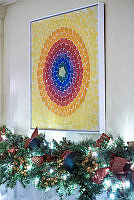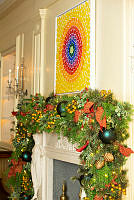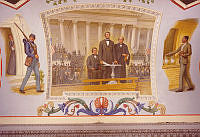Rubenstein Center Scholarship
African Americans Enter Abraham Lincoln's White House, 1863-1865
This article is part of the Slavery in the President’s Neighborhood initiative. Explore the Timeline

Grand Reception at the White House, January 1862.
White House Collection/White House Historical AssociationThe New Years’ Day reception became a White House tradition with President John Adams in 1801 and ended with President Herbert Hoover in 1932. A gala social occasion that attracted the interest of dignitaries, journalists and the general public, it eventually generated crowds of several thousand people who crashed the White House gates for a glimpse of the president or, best of all, a chance to shake his hand. As an idea, the reception represented democracy at its most egalitarian; in reality it was an ordeal and security nightmare that many presidents dreaded.
President Abraham Lincoln never enjoyed the opportunity to celebrate the New Years’ Day reception during peacetime. For him, the event served not just as an opportunity for festivity but as a symbol of hope: for an end to the nation’s terrible Civil War, and for some measure of freedom for enslaved African Americans. In three successive receptions under his presidency from 1863 to 1865, the White House became the scene of events portending a new future for the United States. The president scripted one of these events, but for the others he acted as participant rather than protagonist.
On New Years’ Day, 1863, Lincoln worked most of the morning in his White House office (today the Lincoln Bedroom)—interrupted frequently by callers—to perfect the final draft of the Emancipation Proclamation. He finished before eleven o’clock and dispatched the document to the State Department where the final version would be prepared. Meanwhile the White House staff had been preparing the state rooms for the reception, moving furniture to clear the Green Room and the Blue Room, where space was set aside for the president to receive callers. Lincoln took his place and the doors swung open to admit the first diplomatic guests before noon. Military dignitaries followed, and then politicos and members of the general public.
Scores of hearty handshakes later, in the early afternoon, Lincoln left the receiving line and returned to his office. There he brooded alone, nursing pain in his weary right arm and hand, until Secretary of State William H. Seward entered the room accompanied by his son Frederick and bearing the final version of the Emancipation Proclamation, ready for the president’s signature. Recognizing the moment’s importance, Lincoln spoke before signing: “I never in my life felt more certain that I was doing right, than I do in signing this paper. But I have been receiving calls and shaking hands since nine o’clock this morning, till my arm is stiff and numb. Now this signature is one that will be closely examined. If they find my hand trembled they will say, ‘he had some complications.’ But anyway, it is going to be done.”
And so it was done. Lincoln signed with what appeared to be a slight tremble, and once the ink dried Seward added his signature followed by the Seal of the Union.1
One year later, on New Years’ Day 1864, the reception broke new barriers. Mary Todd Lincoln, who had donned mourning clothes after the death of her son Willie in February 1862 and rarely shed them since, appeared at the event wearing a purple dress with black velvet trim while her husband wore a long black coat. The couple seemed unusually genial as they greeted guests, who included “four colored men of genteel exterior, and with the manners of gentlemen.” Had a black man attempted to do so just a few years earlier, the Washington Weekly Chronicle commented the day after the reception, “he would have been in all probability roughly handled for his impudence.” This time, though, the men were received courteously albeit to the surprise of the attending journalists.2
The day is one which the people seem to enjoy, and one which they want.
On February 23, 1864, two other African Americans appeared for a public event at the White House much to the consternation of some officials and other guests. They were two physicians, Dr. Alexander Thomas Augusta—the Army’s first African-American physician—and his assistant Dr. Anderson Abbott. The latter remembered that the White House was “a blaze of light” for the evening event as the Marine Band played and the two doctors threaded their way through the city’s elite to meet the president. To him they were introduced by Benjamin Brown French, the Commissioner of Public Buildings.
Lincoln greeted Dr. Augusta first. As the two shook hands, Dr. Abbott recalled, Robert Todd Lincoln left his nearby mother’s side, “came up to the President and asked a question very hastily, the purport of which I took to be, ‘Are you going to allow this invasion?’ referring, doubtless, to our presence there! The President replied ‘Why not?’ Nothing more was said and Robert returned to his mother’s side.” The two doctors both greeted the President and First Lady and then proceeded to the East Room, which was “crowded and brilliantly lit up.” Stunned guests stared at them—some in curiosity and others in hostility—as they strode about the room arm-in-arm in the consciousness that they could not have “created more surprise if we had been dropped down upon them through the skylight.”3
Lincoln’s final New Years’ Day reception at the White House took place on January 2, 1865 (since the preceding day had been a Sunday), with the war’s end finally in sight. The mood was an unusual combination of restrained satisfaction and reflection as the president, looking haggard and weary, took his place in the receiving line where he would remain until late afternoon. “The day is one which the people seem to enjoy, and one which they want,” remarked Secretary of the Navy Gideon Welles, while grumbling that “a little more system at the President’s would improve matters.”4
Through the preceding year, White House observers had increasingly noticed large numbers of black faces in the crowds cheering or just watching the president go about his public rounds. On this day, some attempted to work their way in to the building amidst the throng of white visitors—estimated at 7,000—and a few succeeded before guards shut the remainder out. Only late in the afternoon as the white crowd faded were African Americans allowed into the Executive Mansion as a group.5 A condescending account by a white reporter, subsequently reprinted in newspapers nationwide, indicated that “Some of them were richly and gaily dressed, some were in tattered garments, and some of them were in most fanciful and grotesque costume.” All pushed forward to meet Lincoln, who greeted them “with a heartiness that made them wild with exceeding joy.”
Their cheers for the president horrified many onlookers, and the reporter wrote that “For a long distance down the walk, on my way home, I heard fast young men cursing the President for this act.”6 But the precedent already had been set. The courageous decisions of a few, followed by the spontaneous demonstrations of many, had forever breached the racial barrier separating African Americans—acting as free men and women rather than slaves or servants—from the Executive Mansion.





